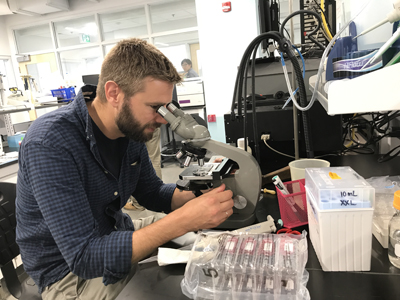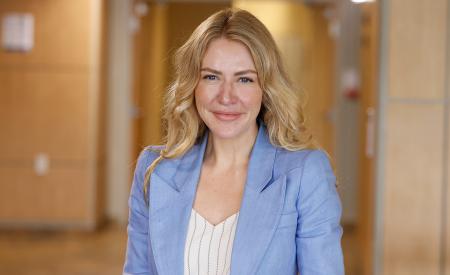Mount Allison welcomes international researcher examining algae from the Greenland Ice sheet to campus
 A piece of Greenland has made its way to Mount Allison University this week as part of an international research collaboration.
A piece of Greenland has made its way to Mount Allison University this week as part of an international research collaboration.
Dr. Chris Williamson from the University of Bristol is visiting the lab of Mount Allison University biology professor and Canada Research Chair (CRC) in Phytoplankton Ecophysiology Dr. Doug Campbell to learn more about ice algae from the Greenland Ice sheet.
“These algae are unique as they grow on the surface of the ice, we can actually see them because of the huge numbers achieved during summer ‘blooms’ and their particularly dark pigmentation, which looks a bit like soot on the ice. When exposed to light (which there is a lot of on the ice surface), they produce a pigment to protect themselves in a way analogous to sun-screen,” says Williamson. “We are hoping to learn more about this process and whether the algae, in this adaptation, are also affecting glacier melting rates in the Arctic by absorbing more incoming sunlight and subsequently warming and melting the ice surface.”
The ice algae Williamson and Campbell are studying are descendants of an ancient group related to the origins of land plants and have many interesting features including high levels of a dark pigment. This helps them to screen themselves from high light exposure on the cold ice, making them visible on the surface, but also appears to increase ice melt due to the extra sunlight that the pigment absorbs.
While previous research has shown this provides an improvement in the microenvironment for the ice algae, researchers like Campbell and Williamson are also seeking to find out if this activity is contributing to glacier melting rates.
Williamson is spending a week in Campbell’s lab to analyze these ice samples before the academic year begins. The lab, located in the Gairdner Building, Mount Allison’s new life sciences research centre on campus, includes specialized equipment to help monitor algae activity. This is Williamson’s third research trip to Campbell’s lab in the past two years.
A microbiologist, Campbell has been a Canada Research Chair since 2002 and was recently renewed as a Tier 1 CRC, which is for seven years and comes with over $1.4-million in research funding over that time period. His research areas look at how different species of phytoplankton — microscopic marine plant organisms — respond to environmental change and includes many international collaborations like the one with Williamson.
“These kinds of collaborations are important to global research,” says Campbell. “We’re pleased to host Chris and assist in his work around the ‘Black and Bloom’ project looking at this particular kind of algae and its behaviour and possible effects on the Greenland ice sheet.”
Note to media: Campbell and Williamson are both available for media interviews the week of August 26-30 on campus. Please contact the Mount Allison communications office for more information (media@mta.ca, 364-2600)




